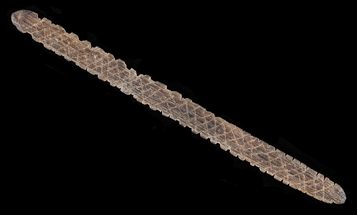| Coordinates WGS84 | 35°33'S, 138°53'E -35.55, 138.88 |
PRM1989_46_2
Title: A message stick held in the Pitt Rivers Museum, and reproduced by A.W. Howitt (1904)
Description: Message stick holder: Pitt Rivers Museum. "Notched 'message stick' with incised criss-cross pattern"; Sketch of message stick (fig. 2) on p. 696 in Howitt's 1904 "The native tribes of southeast Australia"
Date Created: 1883
Notes on date created: terminus ante quem
Item type: message stick in a collection
State/Territory: SA
Notes on linguistic areas: The message stick is associated with Narrinyeri tribe, South eastern Australia mouth of Murray River.
Dimension 1: 135mm Dimension 2: 10mm
Materials: wood plant
Techniques: carved, incised
Sources:
Source types: museum collection, text source
Date collected: June 1883
Institution/Holder file: Pitt Rivers Museum object identifier: 1989.46.2
Collector: Field Collector, Owner: Alfred William Howitt PRM Source: Alfred William Howitt via Edward Burnett Tylor? Acquired: Found unentered 1989; Donated 1888
Coordinates: 35°32'58.498800"S,138°52'57.601200"E (-35.549583, 138.882667)
Media copyright: Pitt Rivers Museum
Notes on coordinates: Approximate point of the Murray Mouth Lookout, South Australia, per Google maps. Wikipedia: Murray Mouth is the point at which the River Murray meets the Southern Ocean. The Murray Mouth's location is changeable. Historical records show that the channel out to sea moves along the sand dunes over time. At times of greater river flow and rough seas, the two bodies of water would erode the sand dunes to create a new channel leaving the old one to silt and disappear.
URL institution: http://objects.prm.ox.ac.uk/pages/PRMUID5155.html
Notes: OT: This message stick does not appear in Howitt 1889 PRM Catalogue: "Related Documents File - Article written by A.W. Howitt entitled: 'Notes on Australian Message Sticks and Messengers' from JAI Volume XVIII 1889 [See file for full text.] [ZM 6/1/2016] Display history: Possibly displayed at the PRM from as early as 1888 with other examples from the Howitt collection of message-sticks (1989.46) (see photograph A23.F11.1, taken in 1995). [JC 11 1 2006] Publications history, trails & websites: See 'Notes on Australian Message Sticks and Messengers', by A. W. Howitt, in Journal of the Anthropological Institute, Vol XVIII, 1889, pp. 314-332. (Copy in RDF). [JC 20 9 2000] Research notes: This is possibly one of the object mentioned in a letter from Howitt [Howitt 10] of the Tylor papers PRM ms collections Box 12 of June 25 1883: 'Dear Dr Tylor Your letter of the 13th May reminds me that I have not yet sent the turndun which I promised in my last letter. The reason is that I have been waiting until I could get them carefully drawn in order that I may have their versimilitudes for reference. I shall now send the following within the next two days in one or parcels [sic] as I find they may require for travel purposes (1) Murring Mudthi (bullroarer) used at Mileatom [?] and found [illegible] factory. [insert] The notch at the end represents the gap where the tooth has been knocked out [end insert] (2) Dieri -- Yuntha (Bullroarer) This was used at the Dieri ceremonies and also by me at those of the Coast Murring (3) Chepara Message stick I am not able to get an explanation of the marks. It seems probable that the existing blackfellows of the Chepara tribe (on the coast south of Brisbane) have forgotten the meaning. Mr Gibson to whom I am indebted for this stick tells me that his informant states that his father used to make these sticks but that he only knew of the meaning of the marks. (4) Dieri message token of Emu feathers. The messenger carries this and delivers the message by word of mouth (5) Narrinyeri message stick No explanation can be given of the marks. Narringyeri tribe is at the Murray River mouth (6) Woi-worung message stick. the marks are said not to have had any meaning beyond being connected in the messengers mind with his message. Woi-worung was the name of the tribe living above Melbourne. (7) Message stick used on the Diamantina River [insert] Queensland [end insert] So far as I can learn the marks are the enumeration of men who are invited to attend the details being given by the messenger. (8) Gournd[insert] i [end insert]tch mara message stick. I am told that this stick was sent with the messenger who conveyed the message by word of mouth (9) Dieri net. This net "yamma" was delivered to the Pinya (armed party) when any person was doomed to death by the Great Council of the Dieri tribe and the offender having been killed, this net was laid upon him as a sign to all concerned. Let me mention here that this Great Council was composed to the principal men of the Dieri tribe. The Heads of Murdus (Totems) Warriors, Orators, Wizards and held its meetings in secret. This great Council was supreme and different from the General Council which consisted of all the initiated men of the tribe. 10. Aaja-dura - Bullroarer. I cannot at present turn up the letter in which my correspondents gave me the name of this example. It was sent to me by the Headman of this tribe which inhabits Yorks Peninsula S.A. in return for a bullroarer which I sent to him. The old man showeed mine to my correspondent with much mystery after sending all the women away from the place These are all the contributions which I can send you this time but more will follow as soon as I can get them drawn -- I do this because I cannot yet tell whether in the work for which I am gathering materials I may or may not require illustrations of these things. This will not however in any way affect any use to which you may decide to put them. They are yours to do with as you like. If there are any other blackfellows implements which you want I shall be delighted to try and obtain them for you. [AP 05/02/2013]"
Media Files:
Data Entry: Olena Tykhostup, Julia Bespamyatnykh




